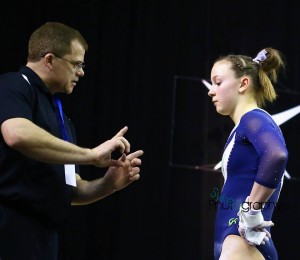Get out of your comfort zone.
UPCOMING W200 COURSE
I will be teaching a W200 course at Bay State Gymnastics Academy in Dartmouth, MA on Sunday, October 19, 2014 12:00 PM
This is a live, six-hour, hands-on training course designed for school age, pre-team and Level 1-4 coaches. This is a NEW course developed for pre team, level 1-4 coaches and even school age recreational coaches. Course topics include warm ups, conditioning, lesson planning, hands on spotting and lecture for all Olympic events. This is a great hands on experience of drills and skill progression with instructors demonstrating practical examples of coaching level 1-4 gymnastics.
The W200 Development Coaches Course: HOTD has been developed to:
Enhance the status of beginning level competitive gymnastics programs throughout the United States.
Establish certificate program requirements which will help identify competent pre-team and competitive (Level 1-4) gymnastics coaches.
Provide appropriate skills, drills and techniques for entry level competitive coaches.
Help standardize pre-team and entry level competitive gymnastics teaching throughout the United States.
Provide resources, instructional materials, and assistance at levels 1-4 coaching
Provides Hands on Spotting on all four Olympic Events.
U200 Development Coaches Course: Sports Science (online) is a companion to W200: Development Coaches Course: Hands on Training (HOTD). It is highly recommended that you complete U200 prior to W200. However, it is not a requirement to take U200 first. U200 covers the sports science aspects of coaching this level athlete including nutrition, biomechanics, injury prevention and psychology.
Attendance to the W200 course is eligible for 6 hours of CPE credit.
BAY STATE GYMNASTICS ACADEMY
24 Ventura Dr N Dartmouth MA 02747
Twisting Drill for Gymnastics
Rebecca Sykes shared this great drill. We have all gotten stuck with a kid or two needing something to fill the gap in twisting.
A+ for creativity! [Read more…]
The Quit Factor: When is it time to quit?
Gymnastics is one of the toughest sports in the world. Countless hours in the gym, sacrificing a social life, pushing your body to exhaustion, and for what? To learn that sometimes even if you try your best, it still may not be good enough? Gymnasts are taught to push themselves almost to their breaking point in order to attain the unattainable: perfection. But what happens when a gymnast actually reaches his or her breaking point? How do you know if it’s really time to throw in the towel?
Read the entire article
Monday Morning Gymnastics Conditioning
For Back (Also great for Leg Drive for Vault) [Read more…]
Canadians turn to USAG Junior Olympic Program.
GYMNASTICS BC WILL BEGIN USING USAG JO PROGRAM
As of September 1, 2014, Gymnastics BC will use the USA Junior Olympic Program (JO) for its provincial level competitive categories. JO will replace the Canadian Provincial Program (CPP), GYMSTART and KIP. Interclub and Performance Plus will continue to be offered, but the athletes will now also have the option to easily transition to the JO program levels 1 and 2.
Fear Not My Canadian Friends!
The JO program. Is pretty basic and straight forward. One of the biggest benefits is that it is fairly easy for parents to understand. SAVING YOU COUNTLESS PHONE CALLS AND E-MAILS.
Where am I and What am I doing?
I have a pretty busy congress and clinic schedule coming up. I received an e-mail yesterday wanting to know WHAT lectures I was doing and WHERE was I doing them.
Here is my schedule- If you HAVEN’T yet registered for one of these congresses or clinics- HOW COME?
If you have any questions that you want to make sure I answer- please do not hesitate to contact me!
Region 4 Congress- Cedar Rapids
June 12
- – Safety and Risk Management
June 13
- – Coaches as Educators (HOW CAN YOU BE A BETTER TEACHER?)
- – Clear Hip Circles and Giants (I will also cover Toe on Handstand)
- – Vault Bridge between Compulsory and Optional (optional drills to do with compulsory gymnasts)
June 14
- – Yurchenko Vaulting 1 (from beginning to first flip)
- – Yurchenko Vaulting 1 (Now that you can flip- what do you do?)
- – Release Moves
June 17
- – Everyday Basics on Floor (a daily plan for basic tumbling. What to do and WHY)
- – Vault Bridge between Compulsory and Optional
- – ABC of Bars. (Today’s Drills tomorrows skills. )
June 18
- – Panel Discussion , (answering those questions which I have brought up in the past)
- – 5 Skills Every Gymnast Needs on Bars
- – Keeping Fitness Fun (Hands on). Fun games!!!!
June 20
- – Building a Team out of your staff (Staff management and motivation)
- – Improve your VAULTING eye. (Judges)
- – Keeping Fitness Fun
- – Release Moves
- – Vault Bridge between Compulsory and Optional (optional drills to do with compulsory gymnasts)
June 21
- – Yurchenko Vaulting 1 (from Beginning to first flip)
GYM MOMENTUM TRAINING CAMP BOSTON
June 26-29
Region 6 Congress. Providence, RI
August 1
- – Vault Bridge between Compulsory and Optional (optional drills to do with compulsory gymnasts)
- – Keeping Fitness Fun
August 2
- Yurchenko Vaulting 1 (from Beginning to first flip)
- Yurchenko Vaulting 2 (Now you can flip- what do you do?)
- Building a Team out of your staff (Staff management and motivation)
August 3
- – ABC of Bars. (Today’s Drills tomorrows skills. )
- – USAG W200
Kidsport Gymnastics Team Camp. Winona Minnesota
August 7-10
National Congress Pittsburgh, PA
August 21
- – School Age Vault.
- – Warm Ups and Wind Downs w/Jayne Marisco. (fun things to get your classes going!)
August 22
- – Hands on Spotting: Women’s Optional Skills Part 1
August 23
- Hands On Spotting-Optional Skills Part 2
TENTATIVE
September 8-22. Training Camp in Iceland.
It is a pretty crazy schedule and it will fill in even more. If you would like me to do a clinic for you at your gym, PLEASE, do not wait too long. I have very few open dates.
If you are coming to one of my lectures, courses or clinics- I have things scheduled pretty tight and I do not know if I have actually scheduled time to EAT. Please bring me a cookie or a piece of fruit.
Do you have a gymnastics PROGRAM? Part 3
I just finished a pretty busy spring where I have been coaching at The International Challenge part of Gym Nix International. A Training Camp in Whitehorse in the Yukon, The University of Calgary International Cup and most recently in Iceland.
At Gymnix there were teams from Canada, US, Sweden, France, Belgium, and Wales.
Some pretty fantastic gymnastics. What was apparent with these gyms was that they a program and a system to become successful. Whether it was Liukin and WOGA or the Team from Manitoba. They had a plan and a system. They nurtured the gymnasts, taught them gymnastics, taught them how to compete. They new where they were and they knew where they were going.
 One of the clubs I consult with KIDSPORT from Minnesota was there. It was their gymnast (Lexy) first International competition. Rob knew what Lexy’s basic bar routine was going to be years ago. There were adjustments (A Comenecci as opposed to a Gienger. A full out as opposed to double lay out) but he had a plan. Watching his videos of 5 kids in a row NAIL triple fulls, and 3 kids in a row do a full in or full out, he obviously has a plan and knows not only what he wants from the group but he also makes wise skill selection for the individuals.
One of the clubs I consult with KIDSPORT from Minnesota was there. It was their gymnast (Lexy) first International competition. Rob knew what Lexy’s basic bar routine was going to be years ago. There were adjustments (A Comenecci as opposed to a Gienger. A full out as opposed to double lay out) but he had a plan. Watching his videos of 5 kids in a row NAIL triple fulls, and 3 kids in a row do a full in or full out, he obviously has a plan and knows not only what he wants from the group but he also makes wise skill selection for the individuals.
Any one can get lucky with a talented kid walking into their gym. BUT- what are you going to do with it? How many kids in a population show above average talent? 1 in 10? 1 in 20? 1 in 100?
How many kids show that SPECIAL thing to bring them to the top? 1 in 1000? 1 in 10,000?
You need to make your gym a magnet for talent. The only way to do that is to:
- take the mediocre kid and make them AVERAGE
- The average kid and make them GOOD
- The good kid and make them GREAT
- And the Great kid and make the AMAZING.
Talk is Cheap
It is so easy to talk about excellence, winning, commitment and leadership but what actions are you actually taking to achieve those things? What is your specific action plan? Who is going to help and guide you? What changes do you need to make to be the best you can be? What are you willing to sacrifice? Stop talking about it and do something now.
The path to EXCELLENCE is paved with good intentions – turn the intentions into action!
Characteristics of a Sound Training Program
In all my travels I have been getting requests to evaluate their training programs. Rather than specifically evaluate any program I think it is better to describe the characteristics of a sound program and you can use this to evaluate and draw your own conclusions.
Technique- You can not argue with physics and mechanics. Our bodies and the equipment react to certain constants and constraints. As I have said before- the technique you teach needs to become your religion.
Progression – You should be able to see clear definitive progression both inter and intra workout. In addition the progression should take into account training age.
Clearly Defined Goals – A sound program starts with the end in mind and clearly works toward that end.
Training is a means to an end – Training should not be an end unto itself.
Individual – A sound training program fits the individual and takes into account trainability and recoverability. Not Every drill is going to work with every gymnast. Not every skill is appropriate for every gymnast.
Beyond the Exercise – It is always more than an exercise or a drill. The drill or exercise is a means to an end.
Can Do – A sound program will focus on what the athlete can do, not what they can’t do. Optimize the strengths and minimize the weaknesses.
Risk – Manage risk by weighing the risk:return ratio of the training methods.
Variation – Incorporate programmed systematic variations to insure continual adaptation.
Spectrum – Incorporate a spectrum of methods that insure all systems are trained all the time.
Basics – Never stray far from the basics, no gimmicks, no fads and no quick fixes.
Do you have a gymnastics PROGRAM? Part 2
Read PROGRAM PART 1.
PLANNING is the key to have a true PROGRAM. When I was still a very inexperienced coach who happened to be working with a group of incredibly talented gymnasts who were having a great deal of success on bars I was asked by a colleague what was my plan. I had a daily routine and a competition plan, but I realized that I did not really have a PLAN on bars. So I spent a few weeks writing down my plan for each event.
- What skills at what age.
- What technique I wanted and WHY.
- What conditioning skills to include to facilitate the skills
- What Progressions for common skill
- What was I looking for in Skill selection
- Expectations at each event for each level.
- Skills for now and skills for the future
For the last 25 years this plan has changed VERY little. It has served as my road map. Yes, different kids visited different towns on that map. Some took some side roads instead of the highway but very few have gotten lost.
I can spot a gym with a PLAN in about 2 minutes watching them train or compete. If I see 4 different techniques with 4 different kids, I am pretty sure that is a gym without a plan. If I see kids wandering around the gym waiting for practice to start and not sure what to do, that is a gym with out a plan. There will always be slight variations in technique depending on certain anthropomorphic factors but when I see completely different technique, I know that is not a road to success.
There will be always be exceptions, but you cannot make the exceptions the rule.
Variety may be the spice of life but it is also true that too many chefs ruin the soup. Each group you coach (and each individual you coach) will be different. Different coaches within a program will take a slightly different approach. In order for a program to work, all parts need to be be organized. Following the same path with accepted techniques and progressions. Like a marriage they need to share the same core values.
Technique and progressions need to be your Religion. You need to believe in them to your core. You can be a convert- (I have been converted with certain techniques) but it should not be easy. You need to stick with it for a while.
Drills are the variety. The Spice. But not the substitute for consistent technique and sound progressions.
The MOST consistently successful programs through out the USA are pretty tight and Top down.
- These are our expectations.
- These are the progressions we will follow from skill A to Skill B
- Here is the map you will follow, you can get off the main road, but do not stray too far
Think of your Program.
Is there just an overall plan with individual coaches free to bring kids up any way they want with any technique?
- Do you have a plan for what skills and progressions need to be taught
- What are the expectations and demands you want?
- What is the technique you want taught for skills?
Do you have a gymnastics PROGRAM? Part 1.
pro·gram
ˈprōˌgram,-grəm/
noun
noun: programme; plural noun: programmes; noun: program; plural noun: programs
1. a planned series of future events, items, or performances.
2. a plan of action to accomplish a specified end.
3. a plan or schedule of activities, procedures, etc., to be followed.
verb
verb: program; 3rd person present: programs; past tense: programmed; past participle: programmed; gerund or present participle: programming; past tense: programed; past participle: programed; gerund or present participle: programing
1. arrange according to a plan or schedule.“we learn how to program our own lives consciously”
Is your Team a PROGRAM or is it a series of loosely related events?
If you THINK you have a program- how tight is it?
As I spend an increasing amount of time in other peoples gyms I am impressed by the planning of some and concerned over the lack of planning by others. I am a firm believer that you need to have a plan to serve as a map for your program. With out it you do not really have any idea of where you are going or what is next.
Early in my career as a coach I was given the advice that to be successful I needed to use the 6 P’s of COACHING (Thank you Kip Reed and Don Tonry)
Proper Planning Prevents Piss Poor Performance
Using the same alliteration Here the the 6 P’s of Essential Training.
Progression – It is a building process where each step is dependent on the step before. Learn it RIGHT the first time
Practical – Get training and preparation done within the context of the time, personnel and facilities available.
Personal – The training must fit the individual; one size does not fit all. Above all make the training yours, own it.
Practice – This is where the rubber meets the road; it is where the plan is put into action on a daily basis. Without purposeful directed practice it is impossible to improve.
Planning – Be proactive, planning allows you to bring the future into the present so you can do something about it.Successful coaches have a daily detailed plan for their journey with built in landmarks to frequently assess their progress to goals.
and above all
Patience – It takes time to grow as an athlete and as a coach. Allow for adaptation and growth. It just takes time.

